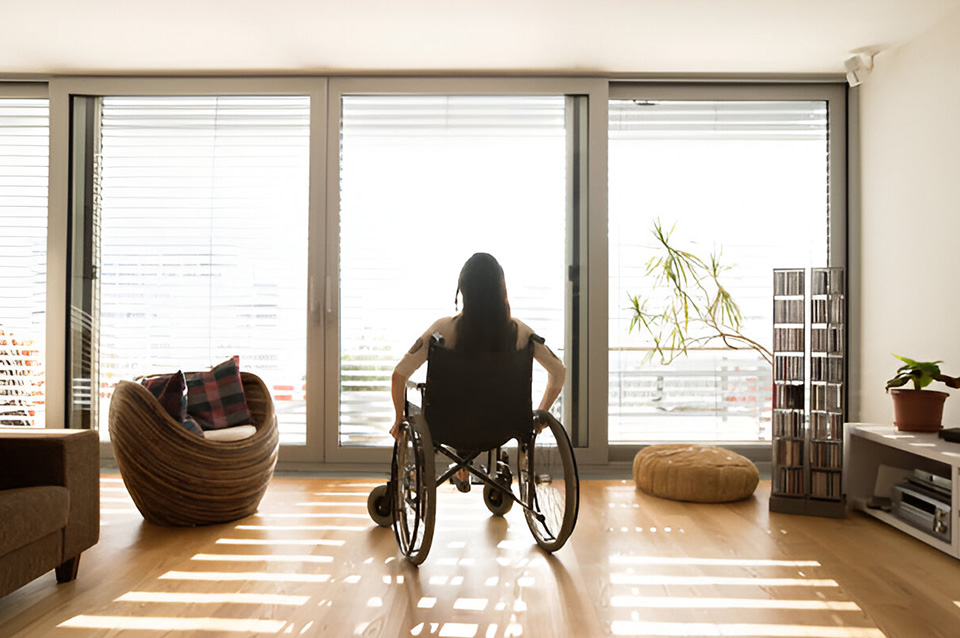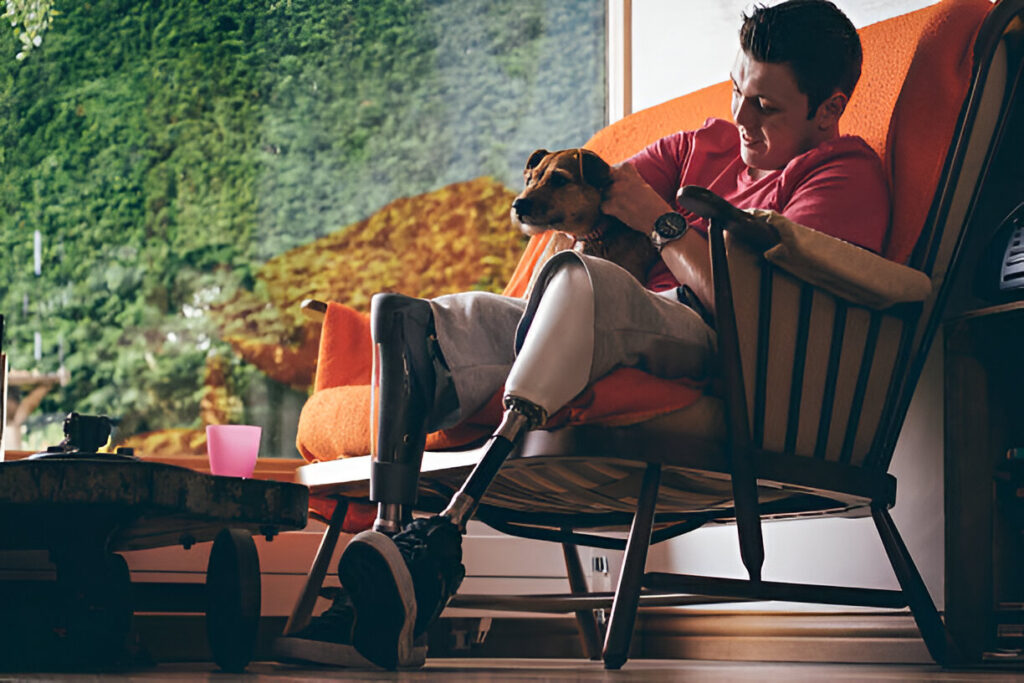Specialist Disability Accommodation (SDA housing NSW) provides accessible, purpose-built homes designed to support NDIS participants with very high support needs. SDA homes include features such as wider doorways, ramps, ceiling hoists, and smart automation to make living safer and more independent. In New South Wales (NSW), SDA is available to eligible NDIS participants who require supported housing. This guide explains what SDA housing is, who qualifies, how it works, and how to find suitable SDA homes in NSW.
SDA housing provides high-quality, accessible homes for people with severe disabilities. It is designed to help residents live independently by incorporating features such as open-plan spaces, single-level layouts without steps, and electronic assistive technology. These features make it easier to provide personal supports safely. Unlike regular rentals, SDA homes are funded through a participant’s NDIS plan. Participants still pay a reasonable rent contribution and normal living costs, but the housing modifications and design features are funded by the NDIS. For example, Sunrise Disability Accommodation offers SDA group homes in Greater Western Sydney that include wide doorways, wheelchair ramps, and voice-activated assistive technology to create spacious, accessible homes that meet Platinum Livable Housing standards.
What is SDA Housing?
Specialist Disability Accommodation (SDA) is a category of NDIS funding dedicated specifically to housing, rather than personal support services. SDA is intended for NDIS participants who need specially adapted housing to access supports and live safely. According to the NDIS website:
Specialist Disability Accommodation is a range of housing designed for people with extreme functional impairment or very high support needs. SDA dwellings have accessible features to help residents live more independently and allow supports to be delivered more safely.
SDA housing means living in a home that has been built or modified to meet very specific mobility, sensory, or behavioural needs. This could be a standalone house, a duplex, or an apartment. The key is that the home is enrolled as SDA and includes features such as widened corridors, reinforced walls, adjustable fittings, ceiling hoists, power backup, or automated doors, depending on the resident’s needs. SDA is transformative for many people with disabilities, turning a standard house into a home tailored to their support requirements. For example, Sunrise Disability Accommodation builds group homes to Platinum standards with features like large windows, ramped entries, and accessible gardens, providing greater independence while ensuring safety for high-support residents.
It is important to note that SDA housing is not simply any disability-friendly home. It is a specific type of NDIS-funded accommodation designed for those who cannot live safely in regular housing because of their disability. All new SDA dwellings must meet the official SDA Design Standard, a nationwide set of construction rules, and be enrolled with the NDIS.
Eligibility Criteria for SDA in NSW
To receive SDA funding in an NDIS plan, participants must meet certain criteria. Most importantly, the NDIS requires that participants have extreme functional impairment or very high support needs and that SDA housing is reasonable and necessary for them. In practice, this means you must be an NDIS participant and your disability must significantly affect your ability to live independently, such as requiring frequent or heavy physical assistance.
Key eligibility points include:
- Extreme functional impairment or very high support needs. For example, you may require a wheelchair full-time, need ceiling hoists or 24/7 support, or have complex health or behaviour support needs. This criterion is assessed by the NDIS based on medical reports and assessments.
- Housing goal in the NDIS plan. You must have a housing goal in your current NDIS plan. If you do not, request a plan review to add a housing goal and ask for SDA funding. Without a housing goal, the NDIS will not consider SDA in your plan. The housing goal should describe the kind of home you want to live in.
- Evidence and assessment. Eligibility is determined at your planning meeting or plan review. You will need evidence, such as reports from allied health professionals, showing how SDA features will help you achieve your goals. Support coordinators and allied health providers often help gather this evidence and submit a Housing Plan to the NDIA.
During the planning meeting, NDIS planners will ask questions such as “Do you need to use a wheelchair at home?” or “Do you require built-in communication technology, alarms, or hoists?” to determine which SDA design category suits you best. If you already live in SDA and your needs change, you remain eligible and the NDIS will help you find an appropriate place. Participants who do not need SDA will be guided towards other home and living supports, such as assistive equipment or home modifications.
SDA Design Categories
All SDA dwellings are classified into one of four design categories. Each category has specific features and caters to different needs:
- Improved Liveability: Homes with better physical access and sensory features. Suitable for people who need minimal physical assistive features but have sensory, intellectual, or cognitive impairments. Typical improvements include very few steps (for example, step-free entry), extra space around key areas, lever taps, easy-to-see flooring contrasts, and built-in communication aids. An example would be a house with nearly flat thresholds, good lighting, and wide hallways so support workers can monitor easily.
- Fully Accessible: Homes with a high level of physical accessibility for wheelchair users or those unable to use stairs. This includes features like reinforced walls for hoists, extra-wide doors and halls to fit powered wheelchairs, and removable sinks or cooktops so a person in a chair can roll under them. An example would be a home where every room has enough clearance for a large wheelchair, and bathrooms can accommodate a shower chair.
- Robust: Very strong and durable housing built for residents with significant behaviour challenges or who risk damaging housing. Robust SDA has impact-resistant walls, windows, and fixtures, and may include alarms or video monitoring. It suits people whose disability may involve property damage or aggression. An example would be a house with protective wall panels, shatterproof windows, and fittings that minimize ligature or damage risks.
- High Physical Support: Homes with a very high level of physical access and specialist equipment for people who need extensive support, often 24/7. These include all the features of Fully Accessible homes, plus ceiling hoists (over beds and in bathrooms), emergency power backup for essential equipment, and voice-activated home automation for lights, doors, and blinds. An example would be a home with a large transfer bathroom, motorised adjustable bed, ceiling lift system, backup generator, and ample room for caregivers to assist.
Sunrise Disability Accommodation designs and builds homes across all these categories and dwelling types, including apartments, group homes, and shared houses. When you apply for SDA funding, the NDIS will decide which of these four categories best suits your needs based on your support requirements and capacity.
Benefits of SDA Housing
For eligible participants, SDA housing offers significant life benefits by providing a safe, accessible home environment. Some key advantages include:
- Greater independence and dignity. SDA homes are designed so people with disabilities can do more tasks on their own. Accessible kitchens and bathrooms allow a person to self-care without constant aid. The NDIS notes that SDA’s accessible features help residents live more independently. Providers confirm that residents feel more in control and confident when living in SDA because they can move freely and manage daily routines safely.
- Safety and quality of life. Features such as ramps, flat showers, and alarm systems reduce the risk of falls or accidents. Robust construction can prevent injuries and avoid the stress of frequent repairs. Emergency and backup systems ensure essential supports, like oxygen machines or hoists, continue even if power fails. Overall, SDA increases quality of life by matching the home to specific needs, such as temperature controls, safe tap handles, and no sharp corners.
- Stable, long-term housing. SDA funding provides secure tenancy and means you are not priced out of suitable housing. Participants have priority access to new SDA builds and can remain in appropriate housing as their needs evolve. Instead of repeatedly moving or compromising on an ill-suited rental, SDA participants can look forward to a stable home base.
- Access to supports and community. Living in SDA often goes hand-in-hand with accessing consistent supports. Some SDA homes are located near community facilities, public transport, shops, and health services. Being in a neighbourhood, rather than institutional settings, promotes social inclusion. Many SDA group homes also allow residents to live with peers, fostering friendships and social life. Sunrise SDA’s group homes aim to feel like real neighbourhood houses with gardens and common areas.
Overall, SDA can transform a person’s experience of home by enabling them to live safely, independently, and with greater comfort.
How to Apply for SDA Housing in NSW
Applying for SDA involves a few important steps, usually in collaboration with your support team:
- Include a housing goal in your NDIS plan. When planning or reviewing your NDIS plan, make sure there is a clear goal about moving to suitable housing. If your plan does not already have this goal, you must request a plan review to add one. For example, a housing goal might state, “I will live in a home with wheelchair-accessible design.” For more information, visit the NDIS housing guide.
- Gather evidence and documentation. Collect reports or assessments from allied health professionals, such as occupational therapists, physiotherapists, or doctors, that explain your functional limitations and need for SDA. Detail why ordinary housing cannot meet your needs. This evidence supports your SDA application.
- Work with a support coordinator or planner. Your support coordinator, if you have one, can help you compile a Housing Plan, which is essentially the SDA funding application. The support coordinator will use your housing goal, goals for independence, and allied health reports to build the case for SDA funding.
- Submit your Housing Plan to the NDIA. Present your Housing Plan at your NDIS planning meeting or submit it during a plan review. The NDIA will assess whether SDA is appropriate. They will review your goals, current living situation, support needs, and the evidence provided. If approved, SDA funding will be included in your plan.
- NDIA assigns a design category. If SDA funding is granted, the NDIS will assign the most suitable design category based on your needs. This tells you and providers what type of home to look for or build.
- Find a home or ask a provider to build one. Once SDA funding is in your plan, you can search for a vacant SDA home or work with a registered SDA provider to develop a new dwelling.
Starting early is important as the application and approvals can take time. Use your housing goal to inform your current plan review. Ask your support coordinator to help coordinate the evidence and review the SDA resources provided by Sunrise Disability Accommodation for additional guidance.
Understanding SDA Pricing and Payments
SDA funding is separate from funding for personal supports. It covers the cost of housing that is built or modified for your needs. Here is how pricing works:
- NDIS Pricing Arrangements and Price Limits. Each year, the NDIS publishes the SDA Pricing Arrangements and Price Limits document. This sets the maximum funding for each combination of design category and building type. These limits reflect the costs of construction, maintenance, and returns for investors. The current 2025–26 SDA price guide is available on the NDIS SDA pricing and payments page.
- SDA Price Calculator. The NDIA offers an SDA Price Calculator tool to estimate how much income a particular SDA dwelling will generate under these pricing rules. Providers use this to calculate expected payments. Participants do not need to use it themselves but it is available for transparency.
- Participant Contributions. Although the NDIS pays for the SDA dwelling, participants usually pay a weekly contribution called the Maximum Reasonable Rent Contribution. This amount is capped by legislation and is usually based on your income. The rest of the rent and other housing costs are paid from your NDIS funds. Participants also pay for ordinary living costs such as electricity and internet.
- Plan Funding. SDA funding appears as a separate budget line in your NDIS plan. It is important that this funding is used for housing. If you do not use it, the NDIS may review or remove it in future plans.
In practice, this means you do not pay out of pocket for home modifications. Instead, the NDIS pays the provider directly. Sunrise Disability Accommodation encourages participants to discuss pricing early with providers. For more details on current SDA prices, visit the official NDIA SDA pricing page.
Finding SDA Housing Providers in NSW
Locating suitable SDA homes requires research and planning. Here are some useful strategies:
- NDIS SDA Finder. The official SDA Finder on the NDIS website is the main tool for finding vacant SDA homes. You can filter by location, design category, building type, and price. It lists homes from registered SDA providers. Check this regularly and register your interest in suitable vacancies.
- Work with your support coordinator. Your support coordinator can help you connect with SDA providers. They often have industry contacts and can advise you on upcoming vacancies or new builds. They can also ensure your funding matches what is needed to move into available homes.
- Sunrise Disability Accommodation. Sunrise is a local SDA developer in Greater Western Sydney. They design and manage SDA homes for NDIS participants, such as Gardenia Grove and Northcott Road, both High Physical Support homes located in Lalor Park, NSW. These homes feature voice-activated systems, wide ramps, ensuite bathrooms, and other high-support features. If you need SDA in western Sydney, consider contacting Sunrise or visiting their SDA Resources page to learn more. You can request a discussion or inspection via their Contact page.
- Local providers and community organizations. Besides Sunrise, other SDA providers operate in NSW, including larger housing associations and disability services. Some may have waiting lists or advertise directly. You can search online for “NDIS SDA providers NSW” or ask your Local Area Coordinator for referrals.
- Location and design considerations. When evaluating SDA options, consider the location’s proximity to supports, transport, and community, the design features to ensure they match your funding category and needs, and the support model available, such as onsite staff or live-in assistance.
Using internal resources like Sunrise’s website and official tools like the NDIS SDA Finder will help you find the best match. Keep your NDIS plan updated with any changes so the SDA funding remains aligned with your goals.
Common Challenges and How to Overcome Them
Accessing SDA housing can involve challenges, but being prepared can help. Some common issues include:
- Limited availability. Demand for SDA housing often exceeds supply, particularly in popular locations. Waitlists for certain types of SDA homes can be long. To overcome this, start planning early, ensure your housing goal is in your plan, and consider flexibility on location or SDA category where possible.
- Administrative delays. NDIA decisions, building approvals, and enrollment of new SDA dwellings can take time. Work closely with your support coordinator to follow up on plan reviews and approvals. Providing complete information can reduce delays. Stay in contact with providers who can advocate on your behalf.
- Design or location mismatches. Available homes may not fully match your NDIS-designated category or location preference. In such cases, discuss options with your NDIA planner or coordinator. They may advise applying for a transfer or using SDA capital funds to modify a home.
- Transitions and plan changes. If you have SDA funding but have not moved into SDA within a plan year, communicate with your planner. Sometimes SDA funding is placed on hold temporarily. Changes in your health or support needs may require plan reviews.
Strategies to overcome challenges include working with disability advocates, Local Area Coordinators, and advocacy groups. Keep clear records and consider temporary accommodation options while continuing your search.
Taking the Next Step Towards Your Ideal SDA Home
Specialist Disability Accommodation is more than just housing—it is a vital foundation for independence, safety, and improved quality of life for NDIS participants with very high support needs in NSW. Understanding the SDA system, eligibility criteria, design options, and funding pathways empowers you to make informed decisions about your living arrangements.
Remember:
- Eligibility depends on having extreme impairment or very high support needs and a housing goal in your plan.
- Design categories ensure you get the home features you require.
- Application steps include setting a housing goal, gathering evidence, and working with a support coordinator.
- SDA pricing is managed by the NDIS, with participants paying reasonable rent contributions.
- Finding housing involves using tools like the NDIS SDA Finder and contacting providers such as Sunrise Disability Accommodation.
- Challenges such as limited supply and administrative delays are real but can be overcome with early planning and advocacy.
At Sunrise Disability Accommodation, we are committed to helping you navigate the journey toward securing an SDA home that meets your unique needs. From guiding you through the application process to offering accessible, purpose-built homes like Gardenia Grove and Northcott Road, our team supports you every step of the way.
If you are ready to explore SDA housing options or have questions about eligibility, funding, or available homes, please visit our SDA Resources page or reach out via our Contact page. Together, we can help you find a specialist home designed to support your independence and wellbeing.
Take the first step today toward a home built around you.


